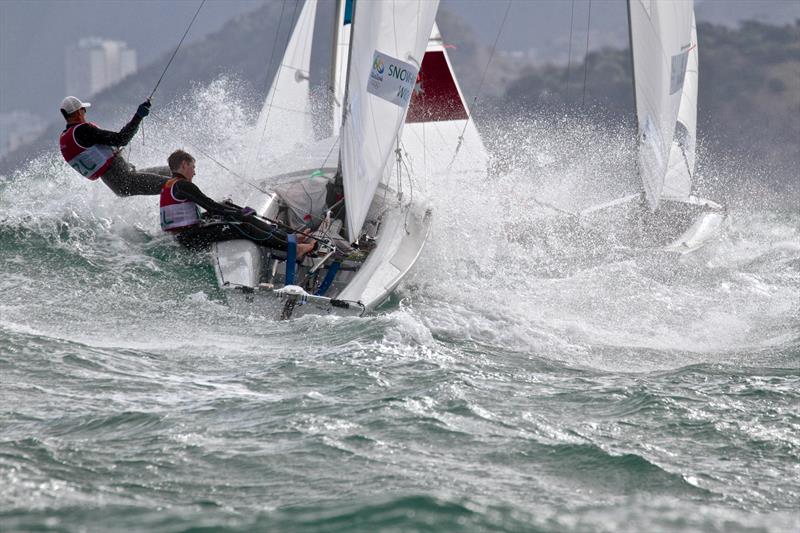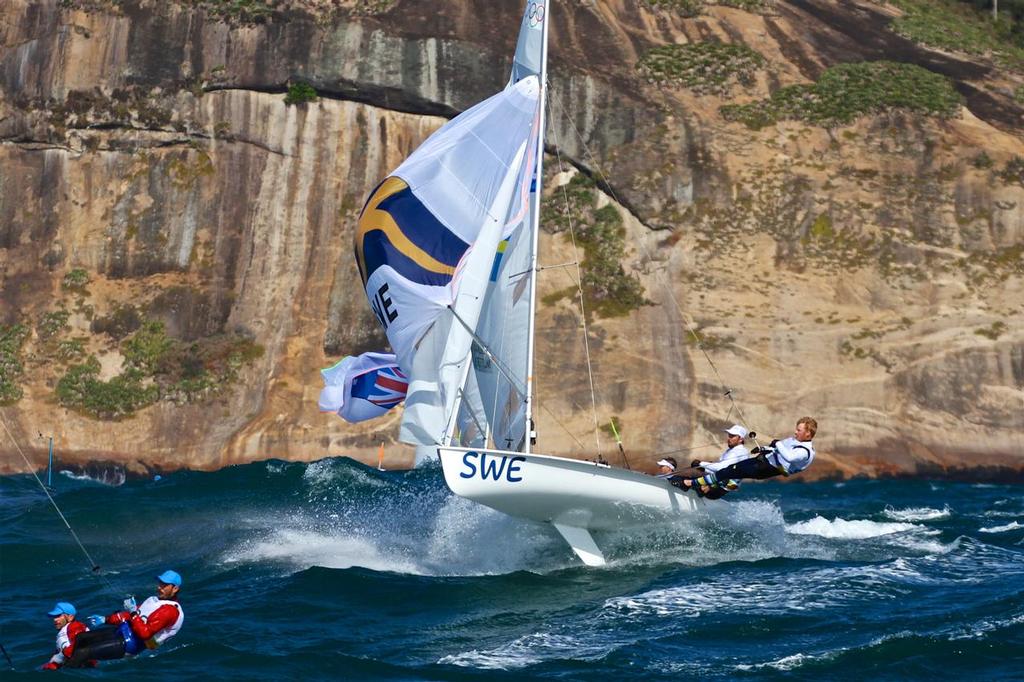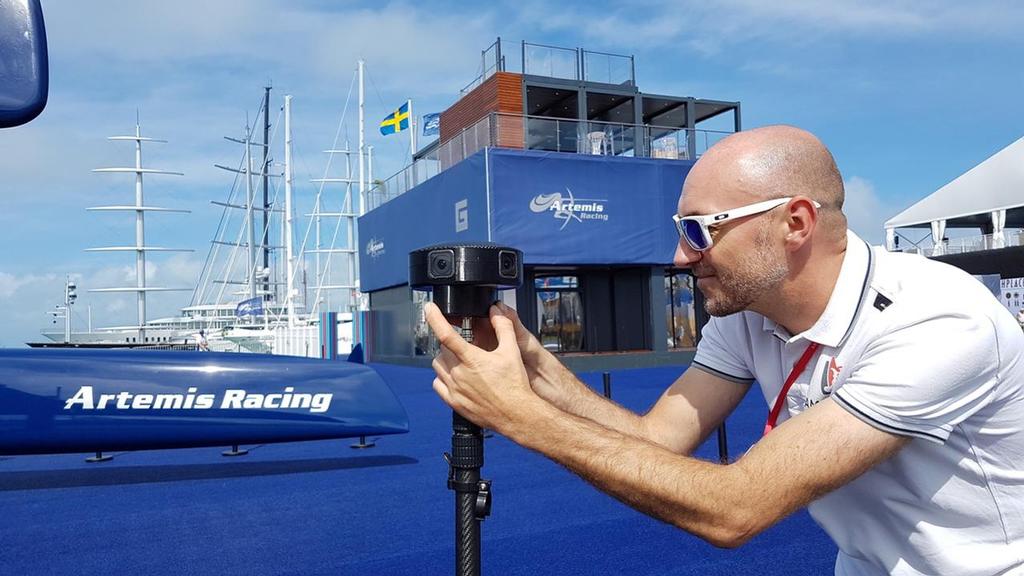
World Sailing: Fixing the real Olympic issues
by Richard Gladwell, Sail-World.com/nz 20 Apr 2018 15:07 UTC
21 April 2018

Olympic racing at its best - Paul Snow-Hansen and Dan Willcox blast upwind on Day 4 of the 2016 Olympic Regatta - a sight not seen by TV viewers © Richard Gladwell
This is the second of a now three-part feature on World Sailing's review of five of the Olympic Events and Classes - as the world controlling body for the sport try to bring in some new options.
Instead of just voting on a plethora of Submissions, a Review is required - which needs to be comprehensive - like the 2009/10 ISAF Olympic Commission Report - looking at all aspects of the Olympic Regatta and the Olympic cycle, and not just the narrow focus of reviewing the older classes to cull and reshape the Olympic fleet.
The Review, like its predecessor will identify exactly what is broken and the options for fixing, as well as what is working perfectly well and should be left alone.
The proposed process will be seen by sailors to be one, like most that have gone before, that is manipulated between various parties and cliques to achieve an outcome that is in their self-interest but not the medium or long term interest of the sport.
In the 2009/10 Review, the evidence, relevant facts, analysis and recommendations were openly available and could be debated.
The report was fair. No-one seriously argued with its content or conclusions - most of which were attempted to be implemented - and some successfully.
Changing the Olympic sailing events mix has significant ramifications outside the Olympic classes - with the investment boats at Youth and Junior level for a class progression that no longer exists.
Once a Youth class progression was put in place that dove-tailed into the Olympic events - it was incumbent on those administering the sport to accept and minimise the effects of Olympic change - because of its effect further down the food chain.
It is also now clear that the direction of travel by World Sailing in regard to the Olympic equipment also appears to have real ramifications in the longer term for the marine industry. The rise of single manufacturer one-design (SMOD) classes in the Olympics has placed power in the hands of a few, without the real checks and balances.
 www.photosport.co.nz"
www.photosport.co.nz" />
Swedish Mens 470 crew launch in the 20-25kts winds and 3-4 metre Atlantic Ocean swells heading for the finish of Race 3 of the Mens 470, 2016 Olympics. Again a sight unseen by the fans. - photo © Richard Gladwell
www.photosport.co.nz
Only two classes (or Equipment) allow open manufacture of sails, and the opportunity has all but vanished for the next Lowell North, Keith Musto or Paul Elvstrom to start up sailmaking and other businesses running out of their garages - to capitalise on their Olympic success.
Same song, second verse with boat building, and spar manufacture - robbing the sport of a lot of innovation in small boats and at a national and international sailing level.
In this Part 1 of the feature, we looked at the background of the current Olympic classes and why things are the way they are.
The history goes back into the 70's and earlier - which for some is a walk back to antiquity. But others prefer to learn from the experience.
The feature was also an attempt to explain why classes like the 470 and Finn have a different foundation than the other four - which are essentially single manufacturer one designs.
The other point is that prior to 1980 there were six Olympic Sailing events - nominally Open, but in reality for Men only. If we applied the current gender equality requirements to the 1980 Olympic fleet composition, there would be 12 Events.
What has happened in transition is that a process of addition and subtraction was employed to bring women's events onto the Olympic slate and cull men's events. We are now at the stage where there are significant issues in that in 1980 the Olympic slate was representative of the sport, and now it is not. What should have been 12 events is now 10 - or in theory, five events for each gender. Small wonder there is class pressure for Olympic survival.
In 1993, the then International Yacht Racing Union changed their requirements for Olympic class selection to accommodate the Laser, and that broke the mould forever allowing the entry of other classes which wanted exclusive manufacturing and supply rights.
Many now feel that the purpose of the latest review is to snuff out both the 470 and Finn and for commercial interests to take almost complete control of the Olympic Equipment.
In no other Olympic sport is the equipment supplied or required to be from a single monopoly manufacturer in the way that it is in Sailing. Rowing - another Olympic boat sport, with very expensive kit has open supply.
The view expressed in the many of the 65 submissions made to World Sailing on the subject of Olympic classes and format seems to be that with a few major changes we will have a fundamentally better regatta, and that will pull the TV punters.
Show Sailing on the Ocean
There are a few issues with that line of thought which repeat the errors of the past - that with the right events and equipment all the current ills will be righted.
First, the Olympic Sailing TV does not show the sport at its best.
In the 2016 Olympics, there was no live TV coverage from the four ocean courses, which produced some of the most spectacular sailing seen in a long while.
It wasn't just on one day either.
Instead, viewers had a steady diet of flat water racing on a dirty piece of water on tight courses with extreme shifts. A day or two of that may be fine, but after ten days it gets tedious.
We've all seen the tremendous video coming from the Southern Ocean, shot by drone cameras in conditions way more severe than the Olympic Regatta. The technology is now available and proven that can bring these same challenging conditions to the TV and other devices for the Olympic Regatta.
Scattered through the Submissions is the hackneyed comment about making the sport more media friendly.
The reality is that while the administrators (who've never had to try and cover one of their regattas) talk media-friendliness in the conference hall, but when they get on the water, it is anything but - with aggressive course marshalls pushing media boats further and further away from the race course.
Learn from Volvo OR and the America's Cup
Secondly, Olympic sailing has to learn from advances in media technology and implement change at an Olympic level.
Sure there were changes in 2012 and 2016 with an onboard camera on each boat in the nominated race of the day.
The real coverage breakthrough for sailing will be the greater use of drone cameras to give better angles and get closer than is possible with helicopters and TV boats.
The second breakthrough change will come with the use of 360VR - trialed in the last America's Cup. The technology creates a new viewer experience by putting the fan on the boat of their choice and watching the race through VR goggles.
Sounds weird? Well, that video that we've all seen of Team Brunel in the Southern Ocean is now available on 360VR (Facebook 360).
With your VR360 goggles on, you can sit just in front of the wheel on Brunel, barrelling downwind in the grey Southern Ocean and two-metre seas. The helmsman is just behind you. There's a grinder to the left and a couple more crew all tethered up standing against the back fence. For 2-3 minutes you can experience sailing in the Southern Ocean and see what its like without the wet and cold. It's an awesome place.
Or like the 360VR clip, we saw in Bermuda of an AC50 race between Emirates Team NZ and Land Rover BAR. How else are you going to experience sailing in a foiling cat in an America's Cup? Short of getting picked for the crew you can't.
Shannon Falcone has posted a video shot on a Garmin VR360 device of a cockpit view of the supermaxi Comanche sailing hard downwind in the Sydney Hobart Race. Again, amazing coverage of sailing. To see a comprehensive review on the Garmin VIRB 360:
As can be seen in the video the device is small, works in water, can be worn on a headband or mounted on a boat in a fixed position and is listed on Amazon for $800.
Whether the device will run in real time and a race can be viewed as it is being played out by the home fan, is another matter - but with any technology we all know that over time, the price will drop, the functionality and quality will improve. So what is not there today surely will next year. What needs to happen at a World Sailing level is that this and other technology is tested, evaluated and embraced to improve coverage and take the fan aboard the boat, instead of running the line that replacing one class with another is the best solution.
The fans need to be shown what a few of us have been able to see from very privileged positions on board media boats on the ocean courses. Sailing is exciting, it is a battle by the sailors against themselves, the elements and their competitors. And it should be compelling viewing on a range of devices beyond just a flat-screen TV.
Even just mounting a VR360 camera on a photoboat during the Olympics would be a big step forward - and then move onto the competitors.
The 360VR experience does give you an appreciation of the sport quite unlike any other medium. The only downside is that it is so good that you'll probably get a touch of sea or motion sickness - while sitting at home. Seriously, it's that good.
In the Olympic Regatta context, 360VR means the fan is on a competitor's boat and can see if they are going to pass the boat to leeward, or by turning their head if they can see whether the boat astern is catching up or dropping off.
For the sailor, the big advantage for the sailor is that adoption of this technology gets a lot of the junk off the course - hefty TV camera boats along with their wakes and blocking of the breeze around marks.
 www.arl.co.nz/"
www.arl.co.nz/" />
ARL's Chris Carpenter sets up one of two 360VR cameras used on Emirates Team NZ and Oracle Team USA to produce the new sailing viewer experience. - photo © ARL Media
www.arl.co.nz/
The Volvo Ocean Race has now developed some very skilled OBR's with excellent drone driving skills. They can fly drones in the Southern Ocean, so an Olympic course should be a walk in the park.
But is World Sailing going to recruit them now, get the systems sorted and use them for the Olympic coverage in two and a bit years time?
Like turning the Titanic
To date change in coverage has been slow - geared by what the host broadcaster engaged by the International Olympic Committee is prepared to do. Usually, that involves a subset of what is done for other sports and what happened at the last Olympics. It's a safe approach but doesn't get you anywhere except to the end of the Olympic Regatta.
After the Olympic Regatta, the sport is judged by the poor ratings, the high costs of coverage and the administrators fall into the trap of thinking that the solution is to change the equipment or events. Or put some gimmicks into the format or courses.
The next Olympic Regatta at Enoshima is on an open water location. So is the 2024 Regatta at Marseille.
Seeing the Olympic classes race on the open ocean in Brazil was an unforgettable experience. It left the so-called Stadium Course for dead.
But you've got to have the boats that can race under those conditions.
Two of the classes that are under Review - the 470 and Finn - were the only ones that can race in the big winds and big seas, and get home unassisted and safely.
Hands on decision makers required
World Sailing doesn't seem to appreciate that the skills and understanding needed to make judgements on these issues and options can't be acquired in the confines of the Chelsea Football Club where the Mid-Year Meeting will be held. They take years of trial, experiment, learning and practice to develop the required level of understanding to make correct decisions.
The perceived problems are not with the Events and Equipment. They are with the people making the decisions and their understanding of what is possible and how you achieve it.
Talking the talk is too easy.
The video and images with this commentary illustrate some of the gains that have been made in other areas of Sailing to keep the coverage in line or ahead of contemporary viewer expectations and technology.
Several are of the Volvo Ocean Race coverage from the Southern Ocean - which begs the question that if it is possible to produce coverage of this standard in the Southern Ocean - then why is it so hard to do it a few miles offshore on an Olympic regatta?
Other videos underlines the skills of the Volvo Ocean Race OBR's in piloting the drones to keep pace with the VO65's sailing at speeds of 20-25kts in big seas.
The drones used are off the shelf models and not particularly expensive.